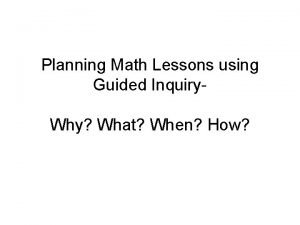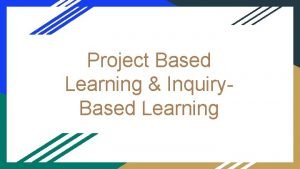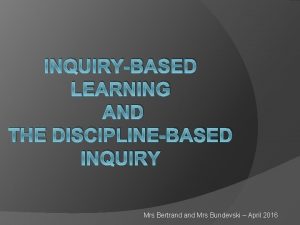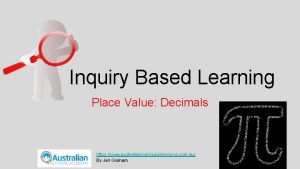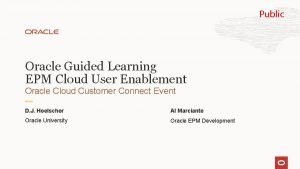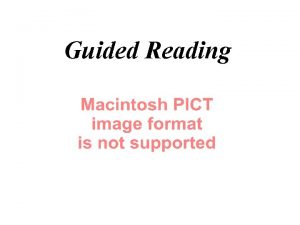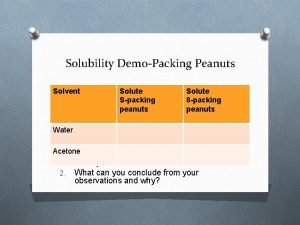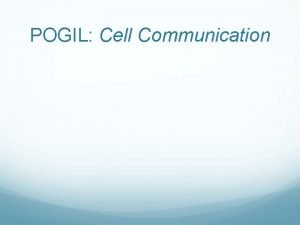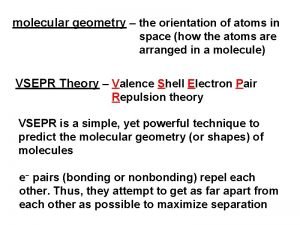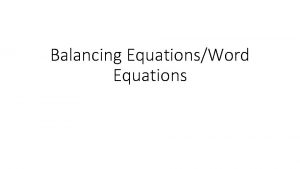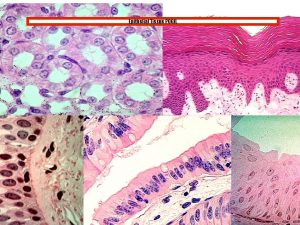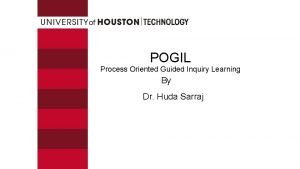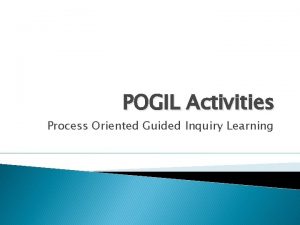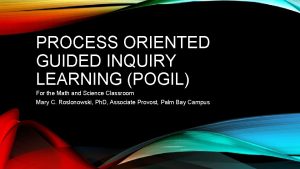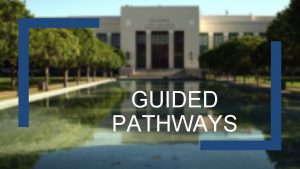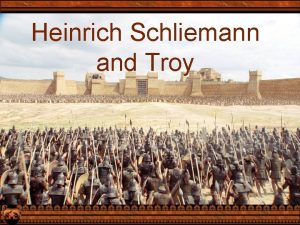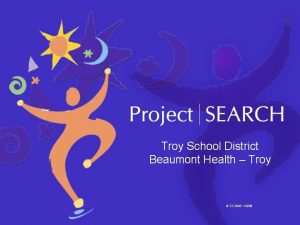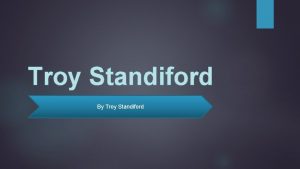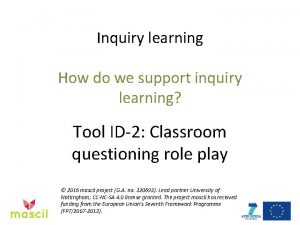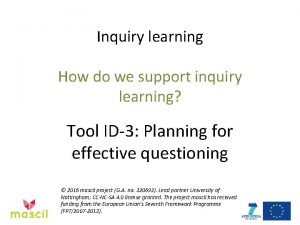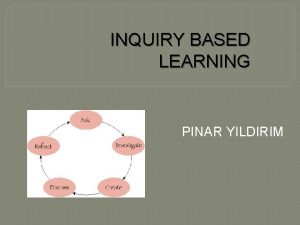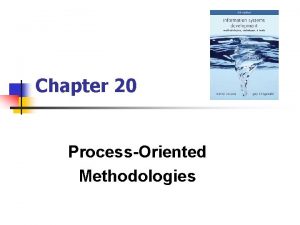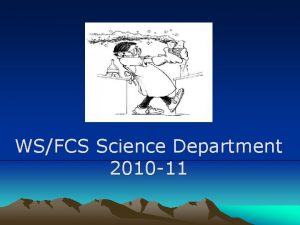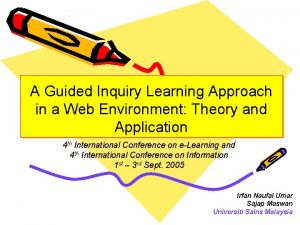POGIL ProcessOriented Guided Inquiry Learning Troy Wolfskill Department






















- Slides: 22

POGIL: Process-Oriented Guided Inquiry Learning Troy Wolfskill Department of Chemistry Stony Brook University Troy. Wolfskill@stonybrook. edu 9/11/2021

Overview The Motivation for POGIL What is POGIL Guided-Inquiry Activity Design Facilitating a Process-Oriented Classroom Impact of POGIL Locally and Nationally

References & Acknowledgements References LUCID - A New Model for Computer Assisted Learning, D. Hanson, T. Wolfskill, J. Chem. Educ. 2001, 78, 1417 -1424. Process Workshops - A New Model for Instruction, D. Hanson, T. Wolfskill, J. Chem. Educ. 2000, 77, 120 -129. Improving the Teaching/Learning Process in General Chemistry, D. Hanson, T. Wolfskill, J. Chem. Educ. 1998, 75, 143 -147. Transforming Large Introductory Classes into Active Learning Environments, N. Duffrin, W. Dawes, D. Hanson, J. Miyazaki, T. Wolfskill, J. Ed. Tech. Systems 1998, 27, 169 -178. www. pogil. org Acknowledgements David Hanson, Prof. of Chemistry, Stony Brook University The National Science Foundation Real-Time Multi-Dimensional Assessment of Student Learning, DUE ASA 0127650 Process-Oriented Guided Inquiry Learning, DUE CCLI-ND 0231120 Development & Field Assessment of Web-Based Activities for POGIL, DUE CCLIEM 0341485 58 Other Funded POGIL Projects Stony Brook University Department of Chemistry Center for Excellence in Learning & Teaching Dan Apple, President of Pacific Crest, pcrest. com

The Motivation for POGIL What issues do you face in helping students learn your course content? What issues do your students face after they graduate from college?

Motivation for Change at Stony Brook, mid 90 s Student attitudes and performance in decline Poor attendance at lectures and recitations Interns reported little correlation between experiences on the job and in the classroom Importance of teamwork in the workplace Emphasis on skills over content Above were consistent with national reports

The Education-Employment Gap Faculty from a prestigious eastern University generated the lists below in response to the following assignments. 1. You are a member of a search committee for a position in a company. What characteristics will you look for in applicants? 2. You are planning your course for next semester. What are the important issues you address in your plan? 1. Employment Criteria Good thinker Problem solver Team player Articulate Good writer Creative Knowledgeable Management skills 2. Course Plans Textbook to use Content to include Homework to assign Logical sequence of topics Quality of lectures Nature of evaluations Composition of exams Provisions for tutorials

POGIL: Process-Oriented Guided-Inquiry Learning POGIL is an instructional strategy that… is Process-Oriented, Students exercise key process skills in class to learn course content Information Processing Critical Thinking Problem Solving Teamwork Communication Assessment Teachers facilitate content learning by helping develop process skills uses Guided-Inquiry, Questions guide students through a learning cycle involving the… Exploration of data, models, materials, or tasks Invention or discovery of new concepts Application in both simple and complex contexts and focuses broadly on Learning… by targeting both content and skills

Activity Design: A Learning Cycle Approach Orientation Exploration Model provides information needed to construct a new concept Directed questions prompt students to explore the model Concept Discovery or Formation Convergent questions promote the identification of relationships Concepts are discovered and then named Application Divergent questions prompt students to consider implications Exercises systematically develop skill in using the concept Problems integrate previous knowledge, provide greater challenge Types of Questions: Directed: specific answer determinable from information at hand Convergent: specific answer requires synthesis of information at hand Divergent: multiplicity of answers requires transfer to new contexts

Sample Guided Inquiry: The Mole Model: Counting Units Large numbers of objects are conveniently counted using counting units. The following are examples of such units. Counting Unit Number Example Pair 2 Socks Dozen 12 Eggs Gross 144 Pencils Mole 6. 022 x 1023 Atoms Notes: 1023 The number 6. 022 x is called Avogadro’s number and given the symbol NA. NA is defined as the number of carbon-12 atoms in exactly 12 grams of carbon-12. NA H 2 O molecules occupy ~18 m. L, which is a little over 1. 6 tablespoons. Key Questions 1. What counting units are listed in the model and what number does each represent? 2. What are the similarities and differences between the counting units in the model? 3. What is the value of Avogadro's number, how is it defined, and how is it related to the mole? 4. How can you determine the number of eggs in three dozen eggs or the number of carbon-12 atoms in 3 moles of carbon-12? 5. How can you determine the dozen of eggs in 24 eggs or the moles of helium in 1. 204 e 24 atoms of helium? 6. How can you use unit conversion to validate that you have correctly converted dozens of eggs to number of eggs or numbers of atoms to moles of atoms? 7. Considering the number of water molecules in 18 m. L of water, why are atoms and molecules counted by the mole instead of other units in the model, and why are eggs usually counted by the dozen instead of the mole?

Student and Teacher Roles in a POGIL Classroom Student Roles Text-Based Workshops Manager Recorder Spokesperson Strategy Analyst Computer-Based Workshops Manager/Spokesperson Technician Strategy Analyst Teacher Roles Leader: Monitor: Plan activities & organization Set objectives & performance criteria Define the reward structure Observe the class, teams, and individuals in action Assess strengths, areas for improvement in content & PROCESS Decide if an intervention is appropriate Facilitator: Intervene with the class, teams, or individuals to help Evaluator: Validate all reported work Assign grades to reward effort, recognize achievement, motivate

Students work in teams on activities…

The instructor facilitates the work of the teams…

Students report their answers to the class…

And develop skills while having fun…

Team Reports Promote Meta-Cognitive Skills In light of the success criteria in today’s activities, what were the most important things your team learned? What is your team still confused about with today’s activities? What were your team’s most important strengths and why? What are your team’s most important areas for improvement and how can you go about achieving these? What insights did you gain into being a more successful chemistry student or problem solver?

Issues in a POGIL Classroom What issues might arise when students work in teams in the classroom. Physical environment Students don’t get along Disagreements Students don’t perform their roles Nobody wants to play their role Students don’t want to work with others Dominating students Teams work at different paces Students don’t focus Distractions Students ride coattails of others 3

Guidelines for an Effective POGIL Classroom For a Performance-Oriented Classroom… Challenging tasks with clear criteria for performance High expectations with respect and no prejudging Mutual trust that promotes risk taking and allows failure High degree of assessment in both quantity and quality Shared commitment with learner ownership of the process For a Team-Based Classroom… Structure the teams Motivate the students Create positive interdependence Assure individual accountability Encourage promotive interactions Provide closure As a team, review these guidelines and come up with at least one question you would like answered.

Facilitation: to make easier Accomplished through interventions in student work Directives Mini-lectures Assessments Strategy Analyst oral reports Instructor’s SII assessment Promoting discussion of reports Team interventions Being playful Spies and Consultants Jigsaw, games, challenges Guidelines for team interventions Reduce effort by only working with managers Intervene on process, not content Ask if they would like assistance Promote critical thinking by asking questions

Effective Intervention Questions… Promote student thinking Promoting: requires reflection, data processing, examining ideas Limiting: requires recall, manipulates thinking Inhibiting: brings closure, promotes fear or intimidation Focus on process Diagnostic: What have you done? Where are you stuck? Prescriptive: What are you given? What do you need to find? What relationships connect givens with unknowns? Reflective: What was the problem? How did you resolve it? How can you avoid it in the future? Can be formulated in various ways to assure student success Directed: specific answer determinable from information at hand Convergent: specific answer requiring synthesis of given information Divergent: multiplicity of answers with transfer to new context

Student Response to POGIL at Stony Brook Attendance was ~90% Overwhelming majority reported that the workshops were challenging, worthwhile, and helped them understand concepts and solve problems ~half reported that their confidence in studying and learning chemsitry was increased by working in a team ~1/3 reported that the workshops increased their interest in chemistry and that self-assessment helped them improve their study habits Students requested that more time be given for workshops by moving them from 55 -minute to 80 -minute blocks Common written comments: When we explain answers to each other it helps us learn the material. We learn skills not just solutions to some problems. They help us reason and think and make us think harder. You learn and understand more by working together.

Impact of POGIL Workshops on Exam Scores at SBU

The POGIL National Dissemination Project Funded by the National Science Foundation 2003 – 2012 Provide Faculty development workshops On-site consulting Visits to schools using POGIL Support by phone, email, and the web Support for developing new curriculum materials One of the most successful teaching/curriculum reform projects that NSF has sponsored.
 Guided inquiry lesson plan
Guided inquiry lesson plan Cuadro comparativo e-learning m-learning b-learning
Cuadro comparativo e-learning m-learning b-learning Pros and cons of inquiry based learning
Pros and cons of inquiry based learning Ngss inquiry based learning
Ngss inquiry based learning Examples of inquiry based learning
Examples of inquiry based learning Inquiry-based learning strategies
Inquiry-based learning strategies Inquiry based learning definition
Inquiry based learning definition Advantages of problem based learning
Advantages of problem based learning Guided learning oracle
Guided learning oracle Guided reading objectives
Guided reading objectives Forms of dna
Forms of dna Solubility pogil
Solubility pogil Cell communication pogil
Cell communication pogil Polar molecules
Polar molecules Phylogenetic trees pogil answers
Phylogenetic trees pogil answers Balancing chemical equations pogil
Balancing chemical equations pogil Photoelectron spectroscopy pogil
Photoelectron spectroscopy pogil Significant zeros pogil answers
Significant zeros pogil answers Introduction to epithelial tissue pogil answer key
Introduction to epithelial tissue pogil answer key Isotopes pogil
Isotopes pogil Punnett square for o blood type
Punnett square for o blood type Pogil epithelial tissue histology
Pogil epithelial tissue histology Chapter 7 review chemical formulas and chemical compounds
Chapter 7 review chemical formulas and chemical compounds
